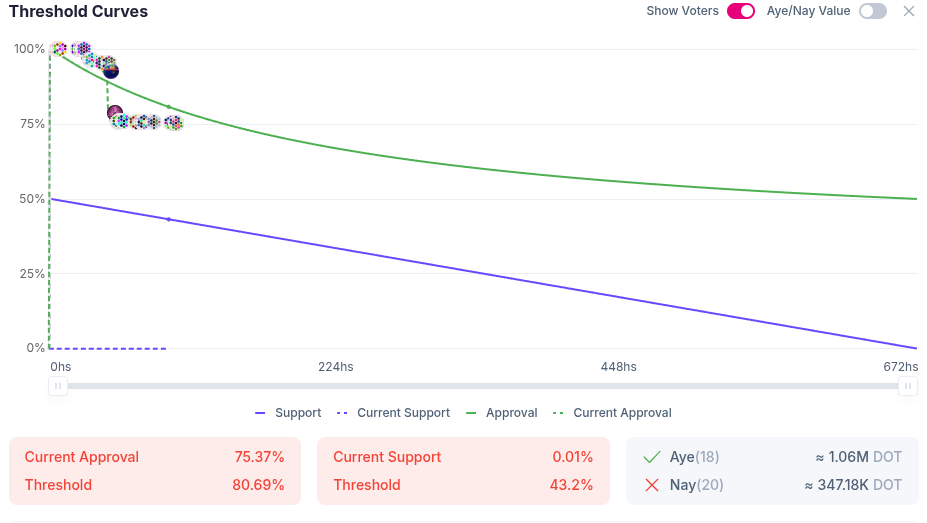pUSD is a proposed DOT-backed algorithmic stablecoin for the Polkadot network that would be overcollateralized using DOT and managed on Acala’s Honzon protocol; early governance votes show strong support with over $5.6M in DOT cast so far, and a governance ballot still open.
-
DOT-backed, algorithmic stablecoin proposal gaining early governance support
-
Proposal leverages Acala’s Honzon protocol and offers an optional savings module to earn stability fees.
-
Voting so far: >1.4M DOT used (~$5.6M) with over 75% of votes in favor and 24+ days left in the ballot.
pUSD stablecoin: Polkadot DOT-backed algorithmic stablecoin proposal shows strong governance support — read key facts, vote stats and design details now.
Polkadot community members are showing strong early support for a proposal to launch pUSD, a native algorithmic stablecoin fully backed by DOT tokens.
Polkadot community governance is weighing a proposal to create pUSD, an algorithmic stablecoin collateralized exclusively by DOT. The plan was introduced by Bryan Chen, co‑founder and CTO of Acala chain, and is designed to reduce reliance on centralized fiat-pegged tokens.

The proposal’s vote stats. Source: Polkadot
What is the pUSD stablecoin proposal on Polkadot?
pUSD is a proposed DOT-backed algorithmic stablecoin intended to operate on Polkadot via Acala’s Honzon collateralized debt position system. The design aims to be overcollateralized with DOT, include an optional savings module, and reduce dependence on USDT and USDC.
How would pUSD be collateralized and governed?
The system would lock DOT as on‑chain collateral and mint pUSD against overcollateralized debt positions. Governance decisions — including parameter adjustments and risk management — would be handled through Polkadot’s governance process, with token holders casting votes to approve deployment and ongoing changes.
At the time of reporting, more than 1.4 million DOT (~$5.6M at ~$3.90 per DOT) has been used to cast votes, and over three‑quarters favor the proposal. The ballot remains open with 24+ days remaining.
Related: Stablecoins: Depegging, fraudsters and decentralization
How is the pUSD stablecoin designed to maintain its peg?
The proposed mechanism relies on economic incentives and smart contract rules to keep pUSD near $1. Overcollateralization creates a buffer against DOT price swings. A stability fee model and an optional savings module would allow holders to lock pUSD and earn yield from collected fees.
Design elements include automated liquidation triggers, dynamic collateral ratios, and governance-set stability fees. These components aim to keep the peg algorithmically rather than depending on centralized fiat reserves.
Why are algorithmic stablecoins controversial?
Algorithmic stablecoins are controversial because prior failures (notably the TerraUSD collapse) demonstrated that algorithmic pegs can break under stress. Still, proponents argue they offer superior decentralization because collateral and rules reside on‑chain.
Industry commentary has highlighted regulatory and compliance risks. Ki Young Ju, CEO of CryptoQuant, has warned such designs could enable noncompliant “dark stablecoins.” These debates play a central role in governance deliberations about pUSD.
Related: Sonic Labs ditch algorithmic USD stablecoin for UAE dirham alternative
When would pUSD launch if approved?
If the governance vote concludes in favor and implementation is approved, development and integration on Acala could proceed under an approved roadmap. Exact timelines depend on on‑chain approvals and technical audits, with governance setting milestones and safety checks before live minting.
Frequently Asked Questions
Is pUSD backed by DOT or fiat?
pUSD is designed to be backed exclusively by DOT tokens via overcollateralized debt positions, not by off‑chain fiat reserves.
How many DOT have been used in the vote so far?
More than 1.4 million DOT have been used to cast votes — approximately $5.6 million at an estimated DOT price of $3.90 — with over 75% voting in favor at the time of reporting.
Can pUSD holders earn yield?
Yes. The proposal includes an optional savings module that allows pUSD holders to lock tokens and earn interest from accumulated stability fees.
Key Takeaways
- Native DOT collateral: pUSD is proposed as an overcollateralized stablecoin backed exclusively by DOT.
- Early governance support: >1.4M DOT (~$5.6M) used to vote and >75% in favor so far, with ballot still open.
- Design & risks: The model relies on on‑chain rules and stability fees; algorithmic pegs remain riskier than fiat‑backed reserves.
Conclusion
Polkadot’s pUSD proposal represents a move to build a native DOT‑backed algorithmic stablecoin that keeps collateral and controls on‑chain. The vote’s early momentum highlights community appetite for a decentralized alternative to USDT and USDC, but the proposal must clear governance, audits, and risk‑management checks before adoption. Stakeholders should monitor on‑chain votes, read technical documentation, and weigh the tradeoffs between decentralization and peg resilience.
